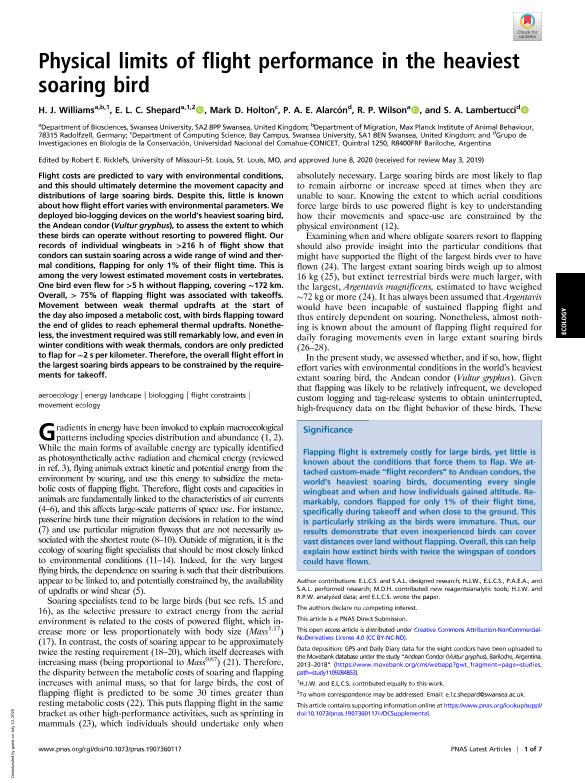Mostrar el registro sencillo del ítem
dc.contributor.author
Williams, H. J.
dc.contributor.author
Shepard, E. L. C.
dc.contributor.author
Holton, Mark

dc.contributor.author
Alarcón, Pablo Angel Eduardo

dc.contributor.author
Wilson, R. P.
dc.contributor.author
Lambertucci, Sergio Agustin

dc.date.available
2023-01-10T13:35:10Z
dc.date.issued
2020-07
dc.identifier.citation
Williams, H. J.; Shepard, E. L. C.; Holton, Mark; Alarcón, Pablo Angel Eduardo; Wilson, R. P.; et al.; Physical limits of flight performance in the heaviest soaring bird; National Academy of Sciences; Proceedings of the National Academy of Sciences of The United States of America; 117; 30; 7-2020; 17884-17890
dc.identifier.issn
0027-8424
dc.identifier.uri
http://hdl.handle.net/11336/184140
dc.description.abstract
Flight costs are predicted to vary with environmental conditions, and this should ultimately determine the movement capacity and distributions of large soaring birds. Despite this, little is known about how flight effort varies with environmental parameters. We deployed bio-logging devices on the world’s heaviest soaring bird, the Andean condor (Vultur gryphus), to assess the extent to which these birds can operate without resorting to powered flight. Our records of individual wingbeats in >216 h of flight show that condors can sustain soaring across a wide range of wind and thermal conditions, flapping for only 1% of their flight time. This is among the very lowest estimated movement costs in vertebrates. One bird even flew for >5 h without flapping, covering ∼172 km. Overall, > 75% of flapping flight was associated with takeoffs. Movement between weak thermal updrafts at the start of the day also imposed a metabolic cost, with birds flapping toward the end of glides to reach ephemeral thermal updrafts. Nonetheless, the investment required was still remarkably low, and even in winter conditions with weak thermals, condors are only predicted to flap for ∼2 s per kilometer. Therefore, the overall flight effort in the largest soaring birds appears to be constrained by the requirements for takeoff.
dc.format
application/pdf
dc.language.iso
eng
dc.publisher
National Academy of Sciences

dc.rights
info:eu-repo/semantics/openAccess
dc.rights.uri
https://creativecommons.org/licenses/by-nc-nd/2.5/ar/
dc.subject
AEROECOLOGY
dc.subject
BIOLOGGING
dc.subject
ENERGY LANDSCAPE
dc.subject
FLIGHT CONSTRAINTS
dc.subject
MOVEMENT ECOLOGY
dc.subject.classification
Ecología

dc.subject.classification
Ciencias Biológicas

dc.subject.classification
CIENCIAS NATURALES Y EXACTAS

dc.title
Physical limits of flight performance in the heaviest soaring bird
dc.type
info:eu-repo/semantics/article
dc.type
info:ar-repo/semantics/artículo
dc.type
info:eu-repo/semantics/publishedVersion
dc.date.updated
2021-09-06T20:36:39Z
dc.journal.volume
117
dc.journal.number
30
dc.journal.pagination
17884-17890
dc.journal.pais
Estados Unidos

dc.journal.ciudad
Washington D.C
dc.description.fil
Fil: Williams, H. J.. Swansea University; Reino Unido. Max Planck Institute Of Animal Behaviour; Alemania
dc.description.fil
Fil: Shepard, E. L. C.. Swansea University; Reino Unido
dc.description.fil
Fil: Holton, Mark. Swansea University; Reino Unido
dc.description.fil
Fil: Alarcón, Pablo Angel Eduardo. Consejo Nacional de Investigaciones Científicas y Técnicas. Centro Científico Tecnológico Conicet - Patagonia Norte. Instituto de Investigaciones en Biodiversidad y Medioambiente. Universidad Nacional del Comahue. Centro Regional Universidad Bariloche. Instituto de Investigaciones en Biodiversidad y Medioambiente; Argentina
dc.description.fil
Fil: Wilson, R. P.. Swansea University; Reino Unido
dc.description.fil
Fil: Lambertucci, Sergio Agustin. Consejo Nacional de Investigaciones Científicas y Técnicas. Centro Científico Tecnológico Conicet - Patagonia Norte. Instituto de Investigaciones en Biodiversidad y Medioambiente. Universidad Nacional del Comahue. Centro Regional Universidad Bariloche. Instituto de Investigaciones en Biodiversidad y Medioambiente; Argentina
dc.journal.title
Proceedings of the National Academy of Sciences of The United States of America

dc.relation.alternativeid
info:eu-repo/semantics/altIdentifier/url/https://www.pnas.org/doi/suppl/10.1073/pnas.1907360117
dc.relation.alternativeid
info:eu-repo/semantics/altIdentifier/doi/http://dx.doi.org/10.1073/pnas.1907360117
Archivos asociados
